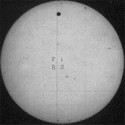History of observation |
|
Only two planets of lunar system of planets are orbiting around Sun closer than Earth and these are concretely Mercury and Venus. They can involve into space between Earth and Sun. If it occures and they involve into low conjunction, we can observe their crossing over the Sun disk from Earth. Johannes Kepler knew this and by his calculation he foresaw transit of both planets over the Sun in his Rudolfian tables in 1631 year. Kepler's assumption and his calculation was true and french astronomer Piere Gassendi transit really observed Mercury in 1631 and at the same time he essayed measure mercurial angular diameter. Thereby he approved the truth of Kopernik's and Kepler's theory about solar system. In 1631 Venus transit wasn't observable. Young Englishman Jeremiah Horrocks computed next Venus transit in 1639. 4.12.1639 he was succsessful and he was thereby first man, which observed and noted rare phenomenon. He measured also mercurial angular diameter and he fount out, it is markedly different than that time specifications. Famous English astronomer Edmond Halley fount the way, how calculate astronomical unit or else intermediate distance between Earth and Sun from times of first and second inner contact (phase T2 and T3). Next years of transits, in 1761 and in 1769, was data measured, noted and from retrieved data there were able then astronomers to calculate with relatively big accuracy astronomical unit - results were between 125 and 153 milions kilometers, it was really success. In the end of 19th century occurred meanwhile last chance to observe Venus transit over Sun. In years of process of phenomena, 1874 and 1882 there were already available photographic technology, so mensuration 1 AU was get on accuracy. In 1874 there was in use however unstable wet method of photografic proces, however from 1882 there were photografic plates by U.S. Naval Observatory saved. |
 |

